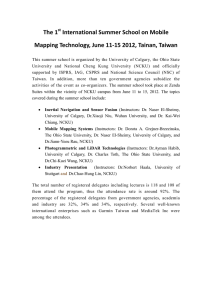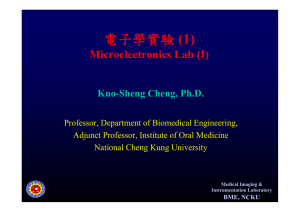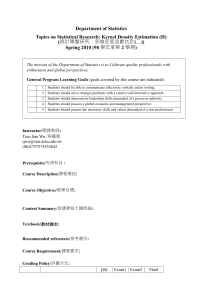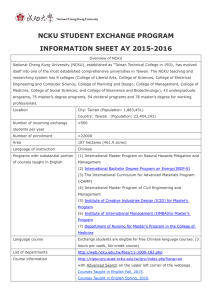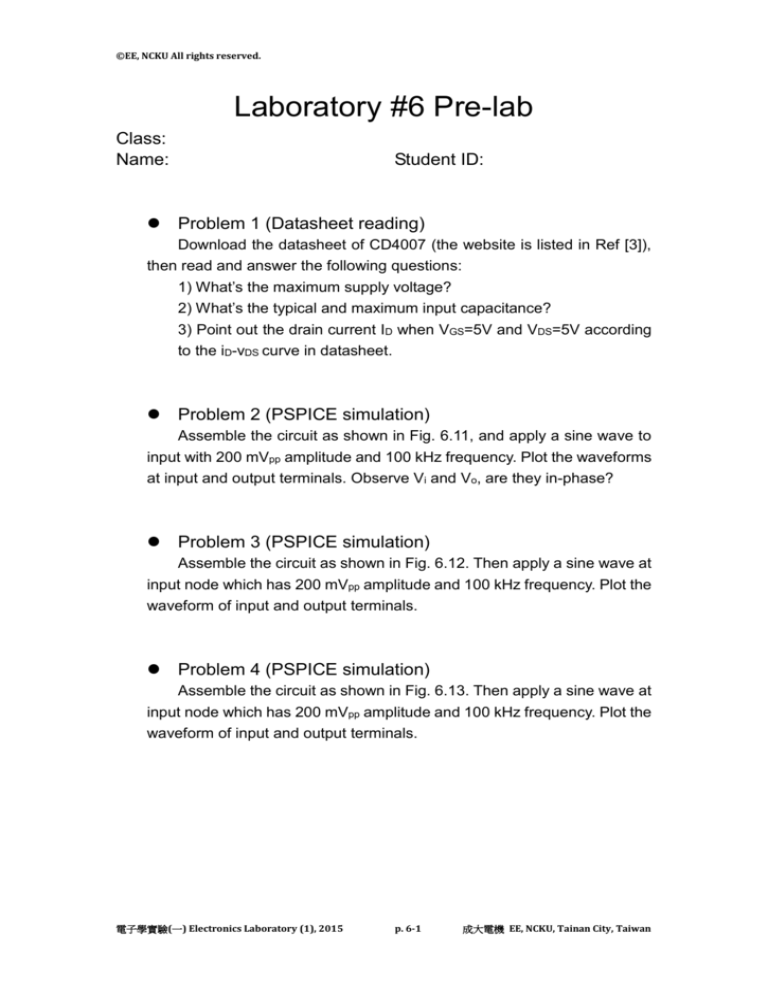
©EE, NCKU All rights reserved.
Laboratory #6 Pre-lab
Class:
Name:
Student ID:
Problem 1 (Datasheet reading)
Download the datasheet of CD4007 (the website is listed in Ref [3]),
then read and answer the following questions:
1) What’s the maximum supply voltage?
2) What’s the typical and maximum input capacitance?
3) Point out the drain current ID when VGS=5V and VDS=5V according
to the iD-vDS curve in datasheet.
Problem 2 (PSPICE simulation)
Assemble the circuit as shown in Fig. 6.11, and apply a sine wave to
input with 200 mVpp amplitude and 100 kHz frequency. Plot the waveforms
at input and output terminals. Observe Vi and Vo, are they in-phase?
Problem 3 (PSPICE simulation)
Assemble the circuit as shown in Fig. 6.12. Then apply a sine wave at
input node which has 200 mVpp amplitude and 100 kHz frequency. Plot the
waveform of input and output terminals.
Problem 4 (PSPICE simulation)
Assemble the circuit as shown in Fig. 6.13. Then apply a sine wave at
input node which has 200 mVpp amplitude and 100 kHz frequency. Plot the
waveform of input and output terminals.
電子學實驗(一) Electronics Laboratory (1), 2015
p. 6-1
成大電機 EE, NCKU, Tainan City, Taiwan
©EE, NCKU All rights reserved.
Laboratory #6 Report
Class:
Name:
Exploration 1
Student ID:
Measure the VG=
input frequency
(Hz)
Vi,pp
(V)
V, VD=
V.
V
Gain= 20 log o
Vi
Vo,pp
(V)
(dB)
100
1k
10k
100k
500k
1Meg
3Meg
5Meg
7Meg
10Meg
Table 6.2
Exploration 2
Measure the VG=
input frequency
(Hz)
Vi,pp
(V)
V, VD=
Vo,pp
(V)
V.
V
Gain= 20 log o
Vi
(dB)
100
1k
10k
100k
500k
1Meg
3Meg
5Meg
7Meg
10Meg
Table 6.3
電子學實驗(一) Electronics Laboratory (1), 2015
p. 6-2
成大電機 EE, NCKU, Tainan City, Taiwan
©EE, NCKU All rights reserved.
Exploration 3
Measure the VG=
input frequency
(Hz)
Vi,pp
(V)
V, VS=
Vo,pp
(V)
V.
V
Gain= 20 log o
Vi
(dB)
100
1k
10k
100k
500k
1Meg
3Meg
5Meg
7Meg
10Meg
Table 6.4
Problem 1
Use MATLAB or Excel to plot the frequency vs. gain figures according
to your measurement results and address the 3-dB bandwidth on result
figure. (Exploration 1, 2 and 3 are required)
Problem 2
Compare your experimental results with the derivations in the
section of “IV. Preparation”. Explain why your experimental results are
different from or matched to the derivations.
Problem 3
Explain the function of each component in common-source MOSFET
amplifier as shown in Fig. 6.11.
Conclusion
電子學實驗(一) Electronics Laboratory (1), 2015
p. 6-3
成大電機 EE, NCKU, Tainan City, Taiwan


